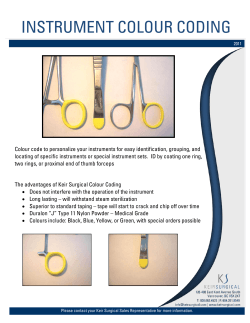
Functions of Total station
Institute of Natural Resources Departament of General Geology and Land use planning Total station Lecturers: Berchuk V.Y. Gutareva N.Y. Contents 1. Definition; 2. Parts of the instrument; 3. The principe of operation; 4. Levelling the Total Station; 5. Levelling the Total Station. 2 Definition Total station or TST (total station theodolite) is an electronic/optical instrument used in modern surveying and building construction. The total station is an electronic theodolite (transit) integrated with an electronic distance meter (EDM) to read slope distances from the instrument to a particular point. Sokia 105 Leica TS 06 Leica TS 09 3 Parts of the instrument A Total station consists of: 4 Parts of the instrument A Total station consists of: 5 The principle of operation The primary function of surveying instruments is to measure distances, angles and heights. The total station employs the electro-optical distance metering method, emitting laser beams to a target and detecting light reflected off it. It takes measurements by calculating the deviation of the wavelength of the reflected light. Total stations are able to measure distances to an accuracy of 2-3 millimeters per kilometer, and angles to 1-second (1°/3,600°) accuracy. One second in an angle is equivalent to the width of pencil lead at 100 meters. 6 The principle of operation Surveying instruments measure angles using a built-in encoder. The encoder is a device that measures the rotation angle and number of rotations of a built-in motor as digital data. To measure the angle to a target point, the system creates a radial pattern comprising 16,200 spokes at equal distance on a glass disc and irradiates light with an LED diode. The encoder detects the rotation angle of the motor by reading changes in the intensity of the projected light. This way, the angle to the target is detected with a resolution down to a one-second angle. 7 The principle of operation There are two methods of measuring distance: the “prism” method, which uses a reflective prism at the target measurement point, and the “non-prism,” or “reflectorless,” method that does not use a reflective prism. With the “prism” method, a laser is beamed at a reflective prism (also called a mirror) placed at the measurement point, and the distance is measured by the time it takes for light to be reflected back from the prism. Though this method is more accurate than the “reflectorless” method, it requires the placing of a reflective prism at the measurement point, making it difficult to measure distances to high locations, diagonal surfaces, or inaccessible locations. 8 The principle of operation With the reflectorless method, it is possible to survey areas from a distant location. Even areas of possible danger such as disaster areas (e.g. landslides) can safely and efficiently be surveyed with this method, which has the additional advantage of requiring less labor and time (there is no need for a second team to handle the prism at the target point). When surveying roads, for example, traffic restrictions need to be put into place if reflective prisms are used. This is not the case with the reflectorless method. The decision to use the prism or reflectorless method is made according to conditions at the survey site. The axes and circles of a theodolite 9 Levelling the Total Station Leveling the Total Station must be accomplished to sufficient accuracy otherwise the instrument will not report results Leveling the instrument – make sure you can see all targets from the instrument station before going through the process The axes and circles of a theodolite 10 Tripod Setup Tripod legs should be equally spaced equally spaced Tripod head should be approximately level Head should be directly over survey point 11 Mount Instrument on Tripod Place Instrument on Tripod Secure with centering screw while bracing the instrument with the other hand Insert battery in instrument before leveling 12 Leveling the instrument Focus the optical plummet on the survey point Adjust the leveling foot screws to center the survey point in the optical plummet reticle Center the bubble in the circular level by adjusting the tripod legs Loosen the horizontal clamp and turn instrument until plate level is parallel to 2 of the leveling foot screws 13 Leveling the instrument Center the bubble using the leveling screws — the bubble moves toward the screw that is turned clockwise Rotate the instrument 90 degrees and level using 3rd leveling screw Observe the survey point in the optical plummet and center the point by loosening the centering screw and sliding the entire instrument After re-tightening the centering screw check to make sure the plate level bubble is level in several directions 14 Functions of Total station 1.It simultaneously measures angles & distances and Record 2. Correcting the measured distance with: 1. Prism constant 2. Atmospheric Pr. 3. Temperature 4. Curvature of earth 5. Refraction correction 3. Computing the point elevation 4. Computing the coordinates of every point 5. Remote elevation measurement 6. Remote distance measurement 7. Area calculations 8. Data Transferring facility from instrument to S/W and S/W to instrument 9. Format of conversion of units 15
© Copyright 2025










